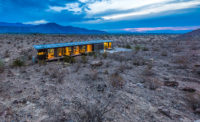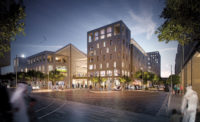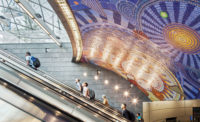Electric lighting has allowed us to transform the night. It extends our workday and permits us to punctuate the nighttime landscape with illuminated buildings. Roadway lights allow us travel on foot and by car safely from point A to B. And illuminated signs and advertisements help businesses sell their products and services.
But too much outdoor lighting can have deleterious effects. One of the most obvious is that it masks our view of the stars. An international group of scientists recently attempted to quantify the magnitude of this long-acknowledged problem with an in-depth study that relied on high-resolution satellite data and sky brightness measurements to map the impact of light pollution around the globe. Their research, published in June in the journal ScienceAdvances, determined that the Milky Way is invisible to more than one-third of the world’s population, including 60 percent of Europeans and nearly 80 percent of North Americans.
However, masking the stars and other celestial bodies from humans is only one of the consequences of light pollution. It can also affect both wildlife and ecosystems.
Bright beachfront lights can attract just-hatched sea turtles, drawing them inland rather than toward the water, making them easy marks for predators. City lights can disorient migratory birds, causing them to fly off course or crash into over-illuminated buildings. Light pollution can even interfere with the tiniest of creatures, including Daphnia, a type of zooplankton that helps keep algae blooms in check. The marine organisms, which dwell deep below the surface of the water during the day, float up at night to consume the algae. Nighttime light can prevent them from doing so. There is also research suggesting that too much exposure to certain types of artificial light can negatively affect human health by disrupting the production of melatonin, a hormone that regulates our circadian rhythms and adjusts our internal clocks.
What is light pollution? Mark Major, principal of London-based lighting design firm Speirs + Major, explains simply that since illumination is a byproduct of energy, if you are using more than is required, or you are putting it where it isn’t desired or necessary, “by definition, that is pollution.”
In only slightly more technical terms, light pollution is the excessive or inappropriate use of artificial illumination. A few of its manifestations are urban sky glow, which is a brightening of the night sky over inhabited areas; glare, or brightness that causes visual discomfort or loss of visibility; and light trespass, the term for light cast where it is not wanted or needed, such as illumination from a streetlight cast into a bedroom, making it difficult to sleep.
Not surprisingly, professional and amateur stargazers were among the earliest proponents for controlling light pollution. One example is the International Dark-Sky Association (IDA), which was founded in the late 1980s by astronomers. The Tucson-based nonprofit organization advocates for smart lighting laws and policies and has an outdoor-fixture-certification program, as well as an initiative that recognizes towns, parks, and developments for responsible lighting practices. “We are not about turning out the lights,” says Pete Strasser, the organization’s technical director. “We are about doing lighting appropriately.”
The outdoor lighting strategies recommended by IDA include luminaires that are shielded to direct light downward rather than up into the sky, are only as bright as necessary, and shut off or dim after hours. Strasser sums up the basics of outdoor lighting as “light where you need it, when you need it, and no more. Everything else is just waste.” The organization estimates that 30 percent of outdoor lighting in the U.S. is wasted, amounting to $3.3 billion and 21 million tons of carbon dioxide emissions per year.
Proponents of turning down the volume on outdoor light point out that more illumination doesn’t necessarily mean greater security. For instance, bright lighting that causes glare is likely to have the opposite effect and make occupants feel unsafe, points out lighting designer James Benya, a principal and partner at Benya Burnett Consultancy in Davis, California. And the IDA maintains that there is no clear correlation between increased outdoor illumination and crime deterrence. It cites research including a 2015 study of street lighting in England and Wales that found little evidence of increased collisions or crime when lights were dimmed, turned off at certain hours, or replaced with more energy-efficient fixtures.
To encourage lighting that protects the night sky and is energy efficient but also provides sufficient illumination levels to make users feel comfortable and secure, IDA and the Illuminating Engineering Society of North America (IES) developed a model lighting ordinance (MLO) that communities can adopt in whole or in part. The document is intended to address inconsistencies in lighting ordinances across the country that vary in technical quality and often use outdated or incorrect terms, says Nancy Clanton, president of Boulder, Colorado-based lighting design firm Clanton & Associates. “Since they are different everywhere, designers don’t know how to comply,” explains Clanton, who chaired the MLO development committee with Benya.
Among the MLO’s key features is the use of five different lighting-zone categories. These range from wilderness, preserves, and undeveloped rural areas, which would be the darkest, to areas that could have very high ambient light levels, such as an entertainment district. The zones provide planning officials with a tool for varying the stringency of lighting restrictions depending on the sensitivity of an area or the preferences of the community. The MLO also relies on a method for rating luminaires, known as BUG (for backlight, uplight, and glare).
Although the MLO has not been widely adopted since its release in 2011, its language, including the lighting zones and the BUG rating system, has been incorporated into a LEED credit for light-pollution reduction, helping focus project teams’ attention on responsible outdoor-lighting design. “It has created an awareness of the problem,” says lighting designer Glenn Heinmiller, a principal at the lighting-design firm Lam Partners in Cambridge, Massachusetts.
One aspect of outdoor lighting that isn’t covered by either LEED or the MLO is the color of the light source. But color is an increasingly controversial topic, especially as traditional halogen sources are replaced with more energy-efficient and longer-life LEDs, which, at least until recently, tended to be cooler or seemingly whiter. In mid-June, the American Medical Association (AMA) released a statement warning of potential health hazards associated with high-intensity bright-white LED streetlights. According to the report, such a lamp “is at least five times more powerful in influencing circadian physiology than a high-pressure sodium light, based on melatonin suppression.” The statement cited recent studies that found that greater residential nighttime lighting is associated with such ill effects as reduced sleep time, dissatisfaction with sleep quality, impaired daytime functioning, and even obesity. The AMA’s recommendations include use of shielded streetlighting, with a correlated color temperature (CCT) of 3000K or lower. (CCT is a specification of the color appearance of light emitted from a lamp measured in degrees Kelvin. Lamps with a higher CCT rating are considered cooler.)
Although the IDA called the report “groundbreaking” on its website, not all lighting professionals are as enthusiastic. Mark Rea, the director of the Lighting Research Center at Rensselaer Polytechnic Institute, in Troy, New York, says that the AMA analysis is “oversimplified.” Rea and Mariana Figueiro, the research center’s program director, issued a response that criticized the AMA report on a number of fronts, but one of the main arguments is that CCT is not appropriate for characterizing the potential health impacts of lighting since the metric “is independent of nearly all of the important factors associated with light exposure, namely its amount, duration, and timing.”
Meanwhile, Lam’s Heinmiller calls the issue of circadian rhythms “huge and important,” but says the focus on CCT is “missing the forest for the trees.” He points out that converting street lamps to 3000K will not by itself solve the problem. “If we are still over-illuminating the environment, we will be creating light pollution.”
Clearly, the science behind outdoor lighting and its environmental and human health implications is complex. But aesthetics should not get lost in the debate, say advocates of sensitive nighttime illumination. Architects and lighting professionals should not think of lighting after the sun sets as an extension of the day, says Travis Longcore, assistant professor of architecture and spatial sciences at the University of Southern California. Instead, he says, their goal should be “nocturnal place-making.”
Read these case studies for more on dark-sky design:
-
806 House, Borrego Springs, California, by Richard Orne Architect
-
Citylights, Paris, by Dominique Perrault
-
Queen Elizabeth Olympic Park, London, by Speirs + Major, Michael Grubb Studio, and
James Corner Field Operations -
Petersen Automotive Park, Los Angeles, by KPF and Horton Lees Brogdon
-
The High Line, New York City, by L’Observatoire International, James Corner Field Operations, Diller Scofidio + Renfro, and Piet Oudolf
-
Patrick's Island Park Calgary, Calgary, Alberta, by Civitas, W Architecture & Landscape Architecture, Tillett Lighting Design
-
Msheireb, Doha, Qatar, by Arup and Allies and Morrison
|
Continuing Education

To earn one AIA learning unit (LU), including one hour of health, safety, and welfare (HSW) credit, read “Dark-Sky Design,” review the supplemental material listed below, and complete the online test. Upon passing the test, you will receive a certificate of completion, and your credit will be automatically reported to the AIA. Additional information regarding credit-reporting and continuing-education requirements can be found online at continuingeducation.bnpmedia.com.
Supplemental Material Joint IDA – IES Model Lighting Ordinance (through page 11)
Learning Objectives 1 Define light pollution and related terms, such as sky glow, glare, and light trespass. 2 Discuss the ecological and human-health consequences of light pollution. 3 Discuss policy efforts aimed at reducing light pollution. 4 Discuss the methods used to minimize light pollution in recent outdoor lighting projects.
AIA/CES Course #K1608A
For CEU credit, read "Designing for the Dark" and take the quiz at continuingeducation.bnpmedia.com, or use our architectural record continuing-education app, available in the itunes store. structure, finishes, and other original fabric when
a building is moved.
significant buildings.
|















Post a comment to this article
Report Abusive Comment